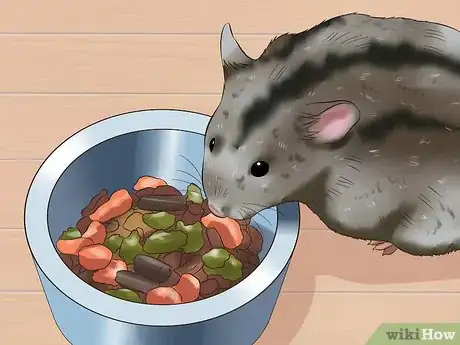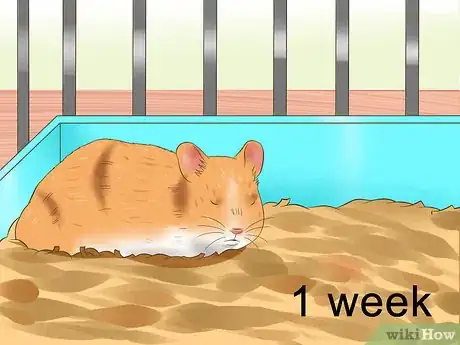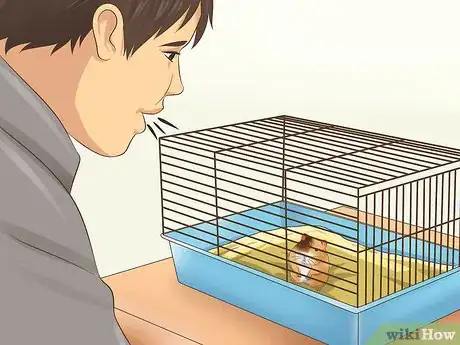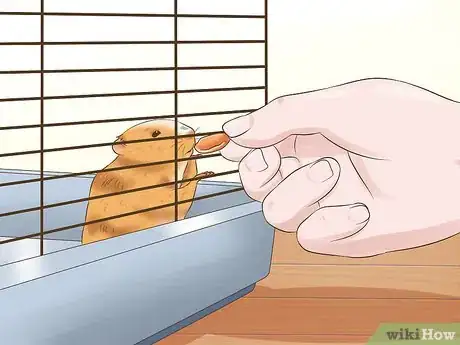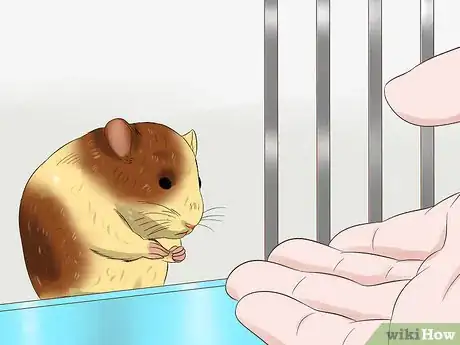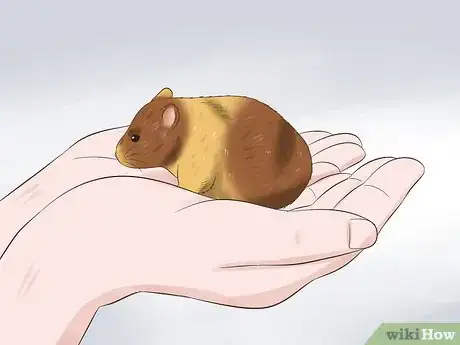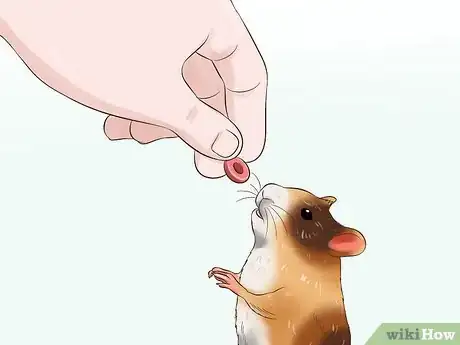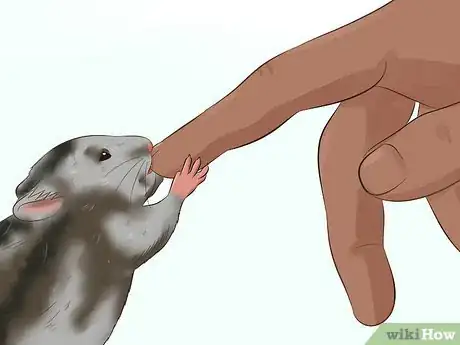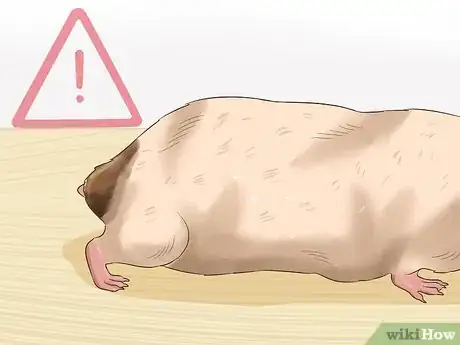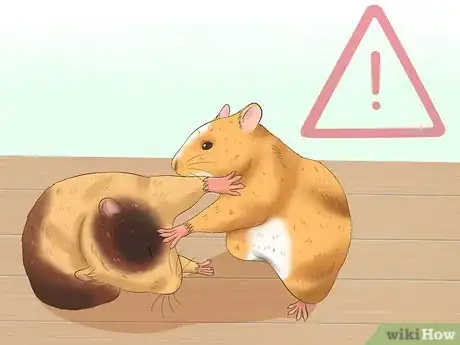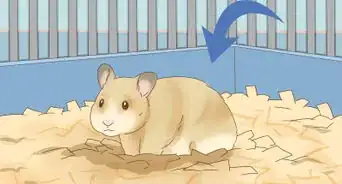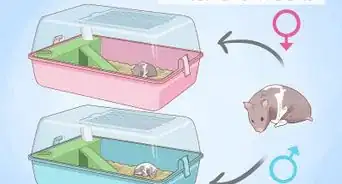This article was co-authored by Pippa Elliott, MRCVS. Dr. Elliott, BVMS, MRCVS is a veterinarian with over 30 years of experience in veterinary surgery and companion animal practice. She graduated from the University of Glasgow in 1987 with a degree in veterinary medicine and surgery. She has worked at the same animal clinic in her hometown for over 20 years.
There are 13 references cited in this article, which can be found at the bottom of the page.
wikiHow marks an article as reader-approved once it receives enough positive feedback. In this case, 85% of readers who voted found the article helpful, earning it our reader-approved status.
This article has been viewed 151,533 times.
Hamsters are very cute and make such great pets. But sometimes they take a little while to warm up to their owners. If you want to tame your pet hamster, you’ll need to spend some time introducing yourself to it slowly and letting it become accustomed to your presence and your smell. Help your hamster feel safe by giving it a comfortable place to live and by letting it warm up to you at its own pace.
Steps
Making Your Hamster Comfortable
-
1Give your hamster a nice home. When you get your new hamster, you’ll need to provide it with a comfortable place to live. This means you need to set up a suitable cage for your hamster. You should put down some absorbent bedding to make your hamster feel comfortable. This also allows your hamster to go to the restroom in its cage. You’ll need to spot clean the bedding daily and replace the entire thing once a week or so.[1]
- Be sure to also put a water bottle for your hamster to drink out of in the cage.
-
2Feed the hamster regularly. Hamsters are omnivores, which means they subsist on animal-based food as well as plant-based food. The most common thing to feed hamsters is dried hamster food pellets, but it is a good idea to supplement your hamster’s diet with small pieces of raw fruits and vegetables as a treat a couple times per week.[2]
- Typically, hamsters should eat about 10 grams of dry hamster food twice each day.
- For a treat, consider giving them small bits of broccoli, peaches, cauliflower, or bananas. Do not give your hamster anything citrus (like lemons or oranges) or acidic (like onions) because it could cause your hamster to get an upset stomach.
- During the first few days after you get your hamster, be careful not to push yourself on it too quickly. This is especially important during feeding time. Just put the food in the cage and then leave the hamster alone to eat in peace. This will help your hamster feel safe around you.
Advertisement -
3Wait a week before trying to touch it. You need to give your hamster some time to get used to you and to feel safe and settled in its new home. Don’t try to force any contact with your hamster for the first week or so.[3]
- Sometimes this process can take a bit longer. It’s important for you to be patient in the beginning.
Introducing Yourself
-
1Help your hamster recognize your voice. When you’re in the same vicinity as your hamster’s cage, try talking to your hamster in a soothing voice. It's natural if the hamster is afraid of you at first. You want your pet to begin to recognize your voice as this will help it learn to not fear you.[4]
- You may want to come near the cage and spend a few minutes at a time (several times each day) just speaking gently to your hamster.
- You can even take the cage lid off after the first few days so that your hamster can hear you better. Just be careful to make sure it doesn’t escape.
-
2Give your hamster treats. Begin to feed your hamster with treats in between the cage bars or through an opening in the top of the cage, depending on what type of enclosure you have for your pet hamster. Associating you with treats will help your hamster get over being afraid of you.
- You can also rub the treat in your palm so the hamster can get to know your scent. Continue for a few days.
-
3Wash your hands. Before you try to pick up your hamster for the first time, you should wash your hands thoroughly. This will remove any scent of food that may be lingering on your hands. You don’t want your hamster to accidentally bite you.[5]
- You can even wear gloves when picking up your hamster in the beginning if you are afraid of being bitten.
-
4Start carefully inserting your hand into the cage. When your hamster is awake, slowly put your hand into the cage. Let your hamster sniff your hand. And don’t force it to do anything. If your hamster is acting scared and backing away from you, remove your hand and try again in another week or two.[6]
- You can also include a couple of treats in your palm to help your hamster feel less afraid.
- Don't pull away when your hamster makes sudden movements at you when you are going to pet or handle it. You are only going to scare it even if it scared you.
-
5Pick up your hamster. Once you have spent some time easing into contact with your hamster, you should try to pick it up. Be sure to hold it firmly in your hand so it doesn’t fall and hurt itself. After a while, your hamster will go into your hand all by itself.[7]
- Never grab your hamster, as your hamster will see that as a threat. Instead, cup your hands and let it walk into your hands on its own.
- If your hamster makes a squeaking noise, that means it is agitated and you should put it back in its cage. Take some more time letting your hamster get to know you before you try to pick it up again.
Strengthening the Bond
-
1Try to make him or her feel safe. Your hamster may be nervous at first, but once you start to pet your hamster and talk to it, it will be calmer than before. Be sure to read your hamster’s body language – if it backs away from you or makes squeaking noises, put it back in the cage. If it seems interested in you and approaches you freely, then feel confident in continuing your course of action.[8]
- You don’t want to try to force your hamster into something that will make it scared. This could be detrimental to the bond you’re trying to build with it. Always make sure your hamster is comfortable with the bonding process before moving on to the next step. It may even take longer to tame the hamster in the long run if you try to rush it.
-
2Continue interacting with your pet. Be sure to spend plenty of quality time with your pet. The more time you spend engaging with one another, the more confident your hamster will be interacting with you. This will lead to a tame hamster before you know it. Soon, your hamster will be very tame and friendly.[9]
- You should try to hold your hamster for at least a few minutes every day. Otherwise, it will be harder for it to get used to you and it will take more effort to tame your hamster.
-
3Show your hamster love. Never forget about your hamster. Remember that you have a little furry friend who wants to play with you and interact. Give your hamster lots of love and affection (and don’t forget the treats!). This is the single most important part of taming a hamster.[10]
- The more you play with your hamster, the more tame it will be.
Addressing Specific Issues
-
1Handle biting hamsters. If your hamster bites you, this usually means that they are scared or anxious. Biting is a natural response to fear for hamsters. If your hamster is biting you, give it some more time before you try to hold it. Keep talking to it and letting it smell your hand occasionally, but don’t force it into your hand for a couple more weeks. Wait until your hamster doesn’t seem nervous anymore (shown by biting, shaking, squeaking) when you put your hand in the cage.[11]
- Be cautious about not waking up sleeping hamsters. This can startle them and cause them to bite.
- Hamsters may also bite if your hand smells like food. So be sure to wash your hands thoroughly before handling your hamster.
-
2Watch out for possible health problems. Since hamsters are such small creatures, you’ll need to monitor them closely for potentially dangerous health problems. While most hamsters are generally healthy, a problem can worsen quickly in a hamster’s tiny body.[12]
- The biggest health problem among hamsters is diarrhea. This condition needs quick vet attention since hamsters can perish from dehydration. The telltale sign that your hamster has diarrhea is when your hamster’s rear end looks wet and brownish in color.
- Another common medical complication for hamsters is protrusion of the eyeball from the socket. This is usually caused by an eye infection or by some other kind of physical trauma. If your hamster’s eyes look like they are bulging, take it to the vet immediately.
-
3Deal with problems among pets. Hamsters can be territorial creatures, which means that they may not like to share their cage with other animals, including other hamsters. If your hamsters are fighting among themselves, you may need to separate them permanently into different cages.[13]
- At the very least, make sure there are no closed off portions of the habitat where one hamster can corner another. And try to make sure there is two of everything so they don’t fight over food and water.
Warnings
- If a hamster bites you, it will be okay. It is most likely you have startled it or your hand smells like food. Remember to always wash your hands before and after you pet your hamster.⧼thumbs_response⧽
- Never bother it while it is eating, drinking, or sleeping.⧼thumbs_response⧽
- Some hamsters are aggressive and fast, so, they tend to bite or run away. If you have a biting hamster, it is best if you use gloves while handling it.⧼thumbs_response⧽
- It is best not to put two hamsters in one cage unless they are Roborovski or Russians. Syrian hamsters will even fight and often will kill each other if they are housed together when they're mature.⧼thumbs_response⧽
- Get a big enough cage for your hamster. Stay away from brands like Kaytee. Remember, the minimum space requirement is 360 square inches.⧼thumbs_response⧽
References
- ↑ http://www.pets4homes.co.uk/pet-advice/caring-for-your-pet-hamster.html
- ↑ https://www.petmd.com/exotic/nutrition/evr_ex_hm_what-can-hamsters-eat
- ↑ http://petcha.com/pets/how-to-hold-and-handle-a-hamster/
- ↑ http://www.petplace.com/article/small-mammals/general/enjoying-your-small-mammal/having-fun-with-your-hamster
- ↑ http://russiandwarfhamsters.tripod.com/hams/id32.html
- ↑ http://harveyhams.weebly.com/taming-a-new-hamster.html
- ↑ https://pethelpful.com/rodents/Handle-Hamster
- ↑ http://animals.mom.me/hamster-trust-1204.html
- ↑ https://www.caringpets.org/how-to-take-care-of-a-hamster/handling-taming/
About This Article
To tame your hamster, talk to it in a friendly, soothing voice when you're giving it food or cleaning its cage so it will start to recognize you. Also, feed it treats between meals, which will make it less afraid of you. When you've spent about a week letting your hamster get to know your voice and building trust, try putting your hand in its cage. Let it sniff you, and see how it reacts. Your hamster may be happy being picked up, or may even walk right into your hand. However, if it acts scared or backs away, give it a little more time before trying again. For information from our Veterinary reviewer on how to strengthen your bond with your hamster once you’ve tamed it, read on!

